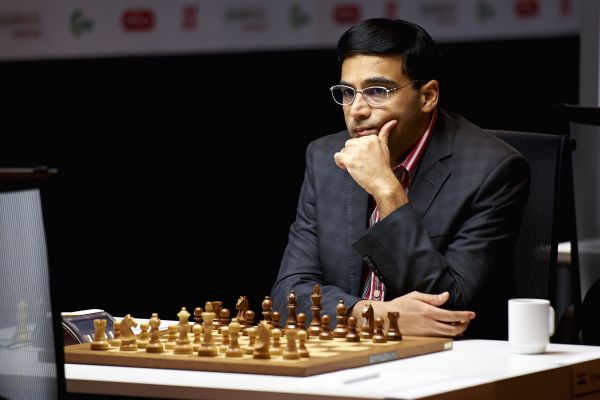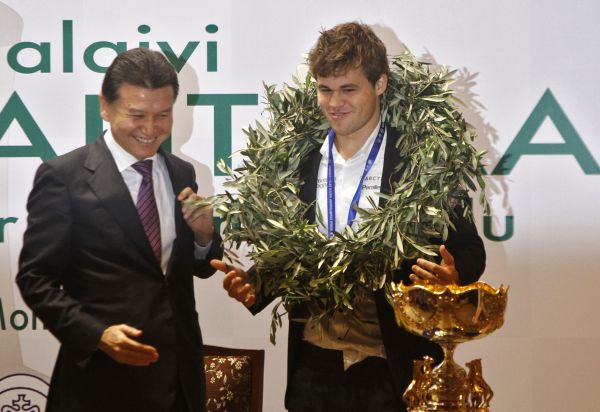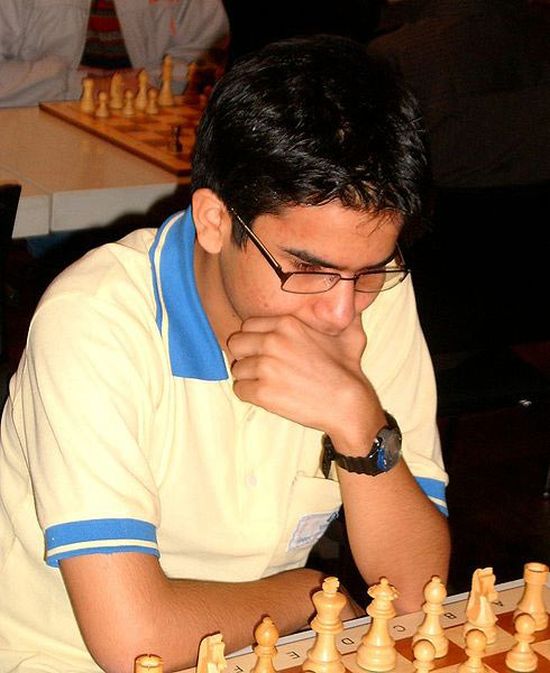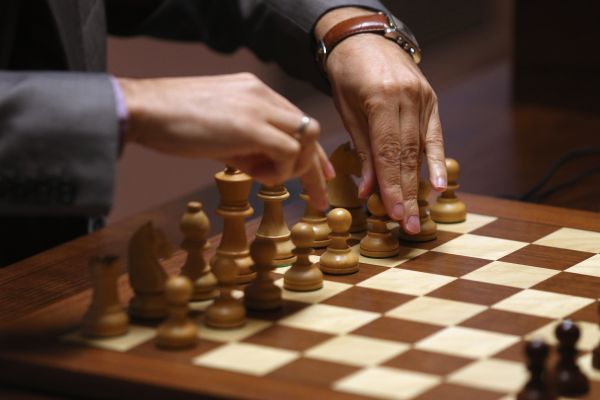 | « Back to article | Print this article |
India's chess future shining and bright
Viswanathan Anand may not quite have an heir yet among Indian chess players, but the country has youngsters with the highest aspirations.
In 1987, Viswanathan Anand put India on the chess map by winning the World Junior Championship (under-20) and he also became the first Indian grandmaster (GM).
At the time, less than 300 Indians were internationally-rated and there were only a handful of International Masters (IMs). The genius from Chennai has since won every trophy and title in the game and his successes have set off an ongoing explosion in popularity for the game.
The former world champion is pushing 44 and entering the final phase of a glorious career. It may be time to ask if there is any Indians capable of emulating his feats in future. A couple have track records suggesting they might have the potential. Three 14-year-olds have also delivered recent performances indicating high levels of talent.
Chess regularly throws up prodigies
Chess regularly throws up prodigies. Careers follow a certain pattern. Young players announce talent early and then work their way up the ladder. Strength develops in bursts if one goes by the statistical evidence of the rating charts. Talented players tend to jump several levels, consolidate, and jump levels again.
A rough rule-of-thumb suggests that the world-class attain grandmaster strength while in their teens and break into the ranks of the top 100 before they are 21. Playing strength peaks in the late 30s, when physical fitness and memory are allied to experience.
Three Indians, apart from Anand, are in the top 100. One of them, Parimarjan Negi, is a junior. On the women’s side, 10 Indians feature in the Top 100 list.
Koneru Humpy is the world number three. She has challenged once for the world title, and is likely to challenge again.
Negi attained GM status just after his 13th birthday, — he was even younger than Magnus Carlsen when he got the GM title. Humpy was also just 15 when she was awarded the GM title.
When one looks at the ranks of the sub-junior (U-16) players, two names stick out as possible world-beaters and a third might also have that potential. Aravindh Chithambaram, a 14-year-old, won the Chennai Open that ran concurrently with the recent world championship. Chithambaram, who is a Fide Master (FM), delivered a spectacular performance, outdistancing a field with 21 GMs and as many as 52 players rated higher than him.
The same 14-15 age cohort also includes the untitled Sunilduth Lyna Narayanan and the young IM, Murali Karthikeyan. Both have registered strong performances in the last year. All three should join the ranks of India's grandmasters in the next year or so.
There are others in the junior category, who are talented but perhaps not exceptionally so, compared to global competition. Apart from Negi, Vidith Gujarathi, Lalith Babu, Sethuraman, Vaibhav Suri, Debashis Das, Sahej Grover, Diptayan Ghosh and Ankit Rajparia are all titled players who make the current list of the top 100 Juniors. It's conceivable that one or more could have a “growth spurt”.
Negi is India's number 3 behind Anand and Harikrishna
The raw statistics indicate how much more broad-based the chess pyramid has become. As of 2013, there are nearly 12,000 internationally rated Indians, including 35 GMs, and India is among the top three chess-playing nations with over 30,000 registered players. At the last Olympiad, both the Indian open and women's teams were seeded (Anand and Humpy weren't playing). The women came within touching distance of medals. Many Indians have also won medals in world age-group and world junior championships.
Negi is India’s number 3 behind Anand and Harikrishna. He’s out-rated at the global junior level by three players. While Negi has won the Asian Championship and has been a silver medallist at the World Juniors, he admits that a breakthrough to the elite super-GM rank has so far, been elusive. He characterised 2013 as a year of euphoric wins (several tournament victories) and crippling disappointments (knocked out in the first round of the World Cup).
Negi says, “It’s the empty spaces — the defeats and the disappointments — that have pushed me forward”. A smart, funny blogger, Negi is a well-rounded personality, listing Ayn Rand, Vikram Seth, George R.R. Martin, and Tarun Tejpal(!) among his favourite authors. The son of an air-traffic controller, Negi plays classical cello and also likes the works of poet-songwriter Leonard Cohen.
Getting the right support
Humpy is the daughter of Koneru Ashok, a well-known amateur on the 1980s circuit. She played a world title match against Hou Yifan in Tirana, Albania, in 2011 and lost. Humpy remains a credible challenger and may force a title match again, since she’s consistently dominated other potential challengers.
The 26-year-old from Andhra would be almost guaranteed a world title except for one thing: the 19-year-old Yifan appears to be just that little bit stronger. If Humpy has adequate support and works past the errors she made in her last title match, she could beat Yifan. Unfortunately, she’s also had a series of disputes with the All-India Chess Federation (AICF) and that has affected the building of a team to help achieve that goal.
Chithambaram first announced his talent by winning the India junior (U-20) title before he was 12 and he also won silver at the world U-16 in 2012. The boy from Madurai was taught to play by his grandfather and he’s trained by GM R B Ramesh at his Chess Gurukul Academy.
Circumstances aren’t easy for the family. His mother was widowed when Chithambaram was three and she scrapes by on her commissions as an LIC agent. Ramesh trains him for free. ONGC offered a scholarship after he won the national junior and that has helped a little.
The Chennai Open was a breakout performance — Chithambaram jumped multiple levels. He beat 4 GMs on the way to a score that suggested super-GM potential. Apart from the splendid result, Chithambaram plays at a speed that suggests an eerie resemblance to the young Anand. He tends to relax during the game by getting up and practising his cricket bowling action.
Anand's legacy
Karthikeyan is slightly younger than Chithambaram and in the same league in terms of talent. Already an IM, he has two GM norms and needs one more good result to take the title. Karthikeyan first served notice about his potential when he won the world U-12 in 2011. He’s the highest rated of this triumvirate of sub-juniors. Sunilduth Lyna Narayanan is a stable performer. The Kerala boy hasn't had spectacular results but he has displayed master strength consistently. He’s also very highly regarded by chess coaches and GMs who’ve watched his play.
There is bound to be more talent in the pipeline, given India’s 30,000-odd regular players and an estimated three million school children learning the game. India's chess ecosystem is also good enough to ensure that if talent emerges, it will be nurtured. But of course, nothing can guarantee the discovery of another incandescent talent like Anand. Genius is unpredictable. Anand and his successor, Carlsen, are living proof — both emerged from places without strong chess cultures.
It is entirely possible that India will not have another world champion for quite a while. But it will have strong teams for sure, and it will have some players with aspirations to the highest. In that sense, Anand’s legacy is secure.
THE RUNGS
Grandmaster (GM): Highest title — awarded to men and women who achieve required norms.
International Master (IM): Second highest title. IM is awarded in gender-neutral tournaments. IM is equivalent to Woman GM (WGM), a title awarded in women's only tournaments. A GM would be expected to score 60 per cent against an IM.
Fide Master: The third highest title — equivalent to a Woman International Master (WIM).
GM/IM/FM Norm: The score a GM, IM or FM is expected to make against a field of given strength.
Internationally-rated player: An internationally rated player is one who has made a designated score in a tournament of specific strength.
Registered player: Someone who plays in a recognised tournament.
Olympiad: The biennial international team championships. It has an open and women's sections.





